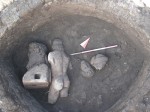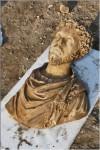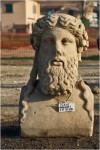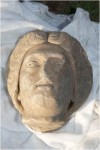 Archaeologists excavating an ancient Roman villa have found six statues from the third century A.D. The villa is now the Roman suburb of Anagnina, southeast of the historic center. In antiquity this would have been the countryside, and the villa a bucolic retreat for a wealthy person of some prominence, probably an imperial functionary.
Archaeologists excavating an ancient Roman villa have found six statues from the third century A.D. The villa is now the Roman suburb of Anagnina, southeast of the historic center. In antiquity this would have been the countryside, and the villa a bucolic retreat for a wealthy person of some prominence, probably an imperial functionary.
 Five of them appear to be busts or portraits of members of the Severan imperial family, including a woman and a child. The sixth is a life-size nude probably of Zeus. Another statue was found from a far earlier period, an archaic Greek herm (a bust carved above a squared pillar of stone), larger than life-sized.
Five of them appear to be busts or portraits of members of the Severan imperial family, including a woman and a child. The sixth is a life-size nude probably of Zeus. Another statue was found from a far earlier period, an archaic Greek herm (a bust carved above a squared pillar of stone), larger than life-sized.
They were discovered in a fountain basin in the atrium of the villa, but they weren’t just tossed in there willy nilly. Between each statue was a piece of tuff, a soft volcanic stone, keeping them from rubbing together.  The villa itself appears to have been sacked at some point in its life, stripped of expensive decorative elements like marble floors and columns, so perhaps the homeowner was trying to save his treasures in anticipation of a return that never happened.
The villa itself appears to have been sacked at some point in its life, stripped of expensive decorative elements like marble floors and columns, so perhaps the homeowner was trying to save his treasures in anticipation of a return that never happened.
The “extraordinary” discovery, one of the biggest and most important in recent memory in the Italian capital, sheds light on housing conditions in the suburbs during the imperial period, the ministry said in a statement.
“It may be that the last owner of the villa was a high-ranking official related to the dynasty” of Roman Emperor Septimius Severus, the statement said.
“The existence of a mausoleum dating back to the late imperial period reinforces such a hypothesis due to the ritual, common in the second and third centuries, of burying the owner next to his house,” it added.
 The villa also shows signs of having been built in stages, with the 3rd century construction being the final stage. That ties in with the Severan clothing and hairstyles of the statues to support the preliminary dating.
The villa also shows signs of having been built in stages, with the 3rd century construction being the final stage. That ties in with the Severan clothing and hairstyles of the statues to support the preliminary dating.
These discoveries are as invaluable politically as they are archaeologically. With the Italian state pretty much broke and draconian budget cuts hitting the culture ministry, the excavation would never have happened without a 100,000 euro donation from a group of private businessmen who wanted to see a proper archaeological exploration of the area before building a public park on the site.
Perhaps you can explain something? The villa is being excavated, so presumably is underground. This seems common with a lot of historical sites. Was the villa covered up by earth naturally or filled over to be built on again?
I think the former. If they had had to demolish structures before beginning excavation, 100,000 euro would not have been sufficient. From the pictures of the site, it looks like the villa was very near to ground level.
Interesting. We have to work hard to keep the ground from eroding!